The most common and dangerous diseases of tomato seedlings. Photos of diseased seedlings, description and signs of damage, preventive measures and effective methods of treating all diseases.
|
Modern tomato varieties are resistant to most diseases, especially during the seedling growth period. But if grown incorrectly, they can still be affected by diseases. |
Tomato seedlings do not have as many diseases as adult plants. But any disease at an early stage can lead to the death of the plant, and sometimes to the complete loss of all seedlings. During the seedling period, it is much easier to prevent a disease than to fight it later. If you care for tomatoes completely carelessly, they can also be attacked by pests.
| Contents: Main diseases of seedlings
|
When grown on a windowsill, tomatoes are sometimes attacked by spider mites.
Diseases of tomato seedlings
The main cause of all diseases of tomato seedlings is poor-quality soil. Before use, it must be either frozen, steamed, or treated with chemicals. The best effect is achieved by treating the soil in combination with one of these methods.
Blackleg
The cause of the disease is contaminated soil. On tomatoes, the pathogens can be both pathogenic fungi and soil bacteria. This distinguishes the “black leg” of tomatoes from that on seedlings of other crops (cucumbers, peppers, eggplants), where the causative agents are pathogenic fungi.
|
This is what a “black leg” looks like on tomato seedlings |
Description of pathogens
Bacterial variety is caused by bacteria of the genus Erwinia. Microorganisms live in the soil and infect potatoes and tomatoes. Tomatoes often get sick in the early period of development. The pathogen enters the plant through microcracks in the roots and lower part of the stem, through root hairs, and also when picking tomatoes.
Favorable factors for the development of the disease are high air humidity, poor ventilation and thickened seedlings.
The pathogen easily spreads to neighboring plants through water, soil and air. Therefore, the bacterial variety is extremely contagious, unlike the fungal form of the disease.
“Black leg” of tomato seedlings is also caused by pathogenic fungi. The spores of the pathogen overwinter and remain on plant debris. The parasite enters the plant through root hairs.
The development of the disease is promoted by elevated soil temperature and moisture.
Signs of defeat
Bacterial form. The source of infection is soil taken from under potatoes. Microorganisms infect the roots and lower part of the stem. The disease usually spreads to all tomato seedlings.
- The first true leaves turn yellow and fall off.
- The plant looks depressed.
- Black-brown or dark green spots appear on the lower part of the stem.
- At a late stage of disease development, a black constriction appears at the bottom of the stem. Tomatoes fall and dry out.
-
In the photo, the bacterial form of “blackleg” The disease develops slowly on seedlings and usually, at home, tomatoes look healthy, but weak.
The full picture of the infection appears after the plants are planted in the ground, although in advanced cases, a constriction of the stem may form already on the windowsill.
If the plant is pulled by the stem, the constriction breaks and dark mucous contents flow out of it - the main indicator of a bacterial infection.
Fungal form. The disease develops very quickly and can destroy tomato seedlings within 1-2 days. It can affect seedlings in the cotyledon leaf stage, but most often enters plants after picking through damaged roots. But from one plant to another it is transmitted only with soil.And if the rest of the tomatoes are healthy and grow in a different soil than the diseased specimen, then they can only get sick when loosening sick and healthy plants with one tool, or when picking healthy tomatoes into contaminated soil.
- The roots are dying.
- The lower part of the stem turns black. Subsequently, the affected part dries out, becomes thinner, forming a constriction, as a result of which water stops flowing into the above-ground part.
- The plant falls and dries up.
If you pull the stem, the plant is easily removed from the soil, since there are practically no roots. The stalk at the site of the lesion does not tear (unlike the bacterial form).
|
In the photo you see a seedling affected by the fungal form of “black leg”. If each plant is grown in a separate container, then the risk of the disease spreading among the seedlings is minimal. |
The difference between a bacterial form and a fungal infection. In case of a bacterial infection, the constriction on the stem is small and a stump of a healthy stem always remains under it. With the fungal form, the stem dries out from the ground, and there are no stumps.
Treatment of the disease
Since the use of chemicals in residential areas is limited, treat this disease pretty hard.
Bacterial form
- When black spots appear on the lower part of the stem, tomato seedlings are shed with a raspberry solution of potassium permanganate.
- Watering at the root with biological preparations Baktofit, Planriz, Vitaplan. After 7 days, re-watering is carried out.
- If the tomatoes are in a greenhouse and are not brought into the house at night, then they can be sprayed and spilled with a solution of Previkur Energy. After 7 days the treatment is repeated. After processing, the tomatoes are shaded.
Fungal form
- Diseased plants are immediately removed.
- The rest of the seedlings are shed with a raspberry solution of potassium permanganate and are no longer watered for a week.
- After 7 days, if there are no new affected plants, the tomatoes are shed with a solution of Fitosporin or Trichodermin.
There are no effective folk remedies for blackleg.
Prevention
Carrying out preventive measures allows you to avoid almost any disease on seedlings, including “black leg”.
Tilling the soil before sowing seeds is mandatory. It is frozen, kept in the cold for several days so that the ground is completely frozen. Then they bring it into the room and allow it to warm up well. When the ground becomes warm, it is taken out into the cold again. The procedure is repeated 2-3 times.
You can bake the soil in the oven. But if it is purchased with fertilizers added to it, then this method will not work, since at high temperatures the fertilizers decompose. In any case, after calcination, Fitosporin or Trichodermin must be added to the soil for seedlings.
|
The simplest, but no less effective method is to pour boiling water with potassium permanganate diluted in it onto the soil. |
Other preventive measures:
- seed treatment before sowing;
- disinfection of containers for seedlings;
- thinning thickened crops;
- rare and not very abundant watering;
- timely picking;
- good ventilation of seedlings.
With proper prevention, the “black leg” will not appear.
How can you save seedlings?
If it is necessary to obtain seedlings at any cost, then the top of the affected plant is cut off and placed in a jar of water. After some time it will give roots. It is advisable to plant such tomatoes immediately in a permanent place. They begin to bear fruit much later and their harvest is lower, but it will still be there.In this way, rare varieties can be preserved.
Fusarium wilt
The causative agent is the pathogenic fungus Fusarium. Lives in soil and plant debris. Favorable conditions for development are soil temperature 22-30°C and high humidity. The development of this disease of tomato seedlings is provoked by the high nitrogen content in the soil. The photo below shows a plant affected by fusarium.
|
This is what fusarium wilt looks like on tomato seedlings. |
Signs of defeat
The pathogen penetrates tissues through root hairs damaged during picking. Affects the vessels of the roots and lower part of the stem. A pink coating appears on the root collar and on the stem near the soil. The lower leaves lose turgor and droop, the veins turn yellow. Since the process develops rapidly on young tomatoes, the leaves do not have time to turn yellow and the tomatoes fall.
When you try to pull tomatoes out of the ground, the stem does not break off, and the roots firmly hold the plant in the soil.
How to treat the disease
Harsh chemicals are used to treat tomato seedlings.
- Watering tomatoes with Previkur, Maxim Dachanik or Vectra. After 7 days, watering is repeated.
- Watering with a dark pink solution of potassium permanganate.
Copper-containing preparations against fusarium are ineffective because they do not penetrate the plant tissue.
|
Treating seeds to prevent fusarium. |
Disease prevention
- Mandatory soil disinfection before sowing.
- Seed dressing.
- Pre-sowing soaking of seeds in a solution of Fitosporin or Planriz.
- Preventive watering of tomato seedlings with biological products (Planriz, Trichodermin, Baktofit, Fitosporin) once every 2 weeks.
- Moderate watering.
- Use fertilizers containing a minimum amount of nitrogen for fertilizing.
- Regular ventilation of seedlings.
Tomato seedlings are rarely affected by fusarium. But if the disease appears, then measures must be taken immediately, since it spreads instantly.
Root rot
The causative agents are soil-dwelling pathogenic fungi.
|
The photo clearly shows the consequences of such a disease. |
Signs of the disease. Depending on the pathogen, they may differ, but the common thing is root rot. The seedlings usually look healthy but suddenly fall over. When you pull tomatoes out of the soil, they are easily removed because the roots have partially or completely rotted. If you dig up the ground, you can find a lump of mucus at the location of the roots.
Control measures only preventative, since the tomatoes look healthy until the very last stage of the disease, and when they fall, there is nothing to treat, since there are no roots.
Prevention consists of drenching tomato seedlings with a slightly pink solution of potassium permanganate once every 15 days. The soil must be disinfected before sowing.
Folk remedies. Water the crop with iodine solution (10 drops per liter of water).
Late blight
Late blight usually affects adult plants during the fruiting period. But it happens that seedlings also get sick, especially if there are infected potatoes in the room at the same time.
|
In the southern regions, the disease often persists on tomato seeds, so sometimes the seedlings become self-infected. |
The causative agent is a pathogenic fungus that infects plants of the Solanaceae family. Among the cultivated ones, these are potatoes and tomatoes. The parasite overwinters on infected fruits and tubers, as well as on plant debris. Late blight is very harmful.
How to recognize the disease
During the seedling period, it affects leaves and sometimes petioles.
- Brown spots appear on the leaves. In young seedlings, they are usually small, there are 1-2 of them on the leaf blade, located along the edge of the leaf closer to its tip. Gradually they spread to the entire leaf blade.
- On the underside, the spots are also brown with a barely visible whitish coating, which may not exist.
- The stains quickly turn black and the fabric dries out.
- Brown streaks appear on the petioles.
Young tomatoes resist the disease quite successfully and usually do not die.
Treatment of the disease
During the initial period of development, tomatoes tolerate late blight without much damage. But, even if the signs of the disease completely disappear, the plants remain carriers of the pathogen and subsequently become ill with late blight very early.
Therefore, if young tomatoes are sick, it is better to throw them away and not risk further harvest. If you need to preserve tomatoes no matter what (for example, a rare variety), then treat them with any copper-containing preparation HOM, OxyHOM, Abiga-Peak, etc., except Bordeaux mixture (it is ineffective for this disease). Signs of the disease may disappear after a single treatment. But in order to prevent the early development of late blight, such tomatoes are planted separately, and treatments with copper preparations are subsequently carried out once every 10 days.
However, symptoms of the disease may remain, but it will develop slowly. It is useless to treat such seedlings; they are thrown away.
Prevention. Tomato seedlings and potato tubers should not be kept together in the same room. You can’t place them together even in a greenhouse. Potatoes for germination can only be taken to a greenhouse where tomatoes will not be grown this year.
Septoria or white spot
The causative agent is a pathogenic fungus. Spores overwinter and remain on plant debris. In addition to tomatoes, eggplants are affected, and less commonly, potatoes.
|
The photo shows a plant affected by septoria. Favorable conditions for the development of disease in tomato seedlings are a temperature of 15-20°C and high soil moisture. |
Signs of defeat. The disease often appears on leaves, less often on stems. In adult tomatoes, flowers and fruits may be affected. In both adult plants and seedlings, the disease begins with the lower leaves. Small dirty white spots with a brown border and brown dots in the center appear on them. Gradually, the spots grow, merge and spread throughout the entire leaf blade. The leaves turn brown, curl, dry out, and the disease progresses, rising up the stem.
How to treat. When early infection with septoria blight occurs, plants die. If it is late, if it is not treated, you may lose your harvest.
If septoria blight appears on already strong seedlings, then the diseased leaves are cut off and the seedlings themselves are sprayed with copper preparations. Repeated spraying is carried out after 10 days. If the tomatoes become diseased at an early stage, they are removed because it is useless to treat them.
All healthy seedlings of not only tomatoes, but also peppers and eggplants are removed from the affected plants.
Prevention. Mandatory soil disinfection and seed dressing.
Bacterial mottling
The causative agent is bacteria. Leaves are affected. The pathogen penetrates through mechanical damage to tissues and through stomata. They overwinter on plant roots in the soil and are not preserved in a free form. When the disease is controlled, its harmfulness is low.
|
Bacterial mottling on tomato leaves. |
Signs of the disease. Bacterial mottling begins on the lower leaves. Small brown spots with a yellowish border appear on them. Gradually, the spots increase in size, the leaf becomes yellow. Later, the spots merge, the leaf curls and dries out.
How to cure. Since the disease is not harmful and spreads slowly, it is enough to pick off the diseased leaves. However, in advanced cases it can spread faster. Because it is undesirable plant in the ground sick seedlings, then they are sprayed with the preparations Baktovit, Trichodermin.
Prevention. Since the disease begins to progress at high temperatures and humidity, to prevent the disease, reduce the temperature, especially at night, and reduce watering.
Pests of tomato seedlings
In apartment conditions, young tomatoes can be parasitized by spider mites. This pest extremely rarely affects tomatoes and can attack seedlings only when it is very widespread and there is a lack of food supply. Often found among those amateur gardeners who are fond of indoor flowers. In the photo below there is a plant entangled in a web.
|
The main pest of tomato seedlings is the spider mite. |
Description of the pest. The mite is microscopic in size and greenish-yellow or orange in color. The pest is extremely prolific. At home, a new generation appears every 8-10 days. Arachnids are very voracious and, if there is a lack of food, they can even attack plants that are usually unsuitable for them.
Signs of defeat. Tomatoes are usually not affected by spider mites. They are repelled by the hairy leaves and tomato smell. But with a high concentration of pests in a small area, they also damage tomato seedlings.The pest feeds on leaves, sucking the juice from them.
Numerous light dots appear on the leaves - puncture sites, and grayish spots - waste products of the mite. The plant is entangled in a sticky web. Gradually the leaves dry out and fall off.
Control measures. Usually the mite does not cause serious damage to tomato seedlings, but if the infection is severe, young tomatoes may die.
Before carrying out treatment, the cobwebs should be removed, as they prevent drops of drugs from reaching the leaves.
|
The simplest, but extremely effective method of controlling mites is to increase the humidity around the seedlings. |
To do this, water the tomatoes well and spray with warm water. Then the seedlings are covered with film or some material that does not allow moisture to pass through, and placed in a sunny place for 2-3 days. Ticks that cannot tolerate high humidity die quickly. After 3 days, the seedlings are opened and thoroughly ventilated. There is no need to water tomatoes so as not to provoke the appearance of diseases.
If this does not help, then the seedlings are taken out to the greenhouse or onto the balcony and treated with Bitoxibacillin, Agrovertin, Akarin on the underside of the leaf.
Tomatoes at a young age are quite resistant to diseases and pests. And their appearance is associated with gross violations in the cultivation of tomatoes.
Problems when growing tomato seedlings
Main problems:
- seedlings stretch;
- plants dry out;
- weak tomatoes with small leaves;
- yellow leaves with green veins.
With proper care, there are no problems with tomatoes.
Difficulties with growing tomato seedlings are much more common than diseases.
The seedlings are stretched
In indoor conditions, tomatoes always stretch out due to lack of light.Even with backlighting, but cloudy weather, the plants still stretch, although not as much. For normal development of seedlings, they need the sun, which nothing can replace. To enhance the illumination of the tomatoes, place foil, reflective film or a mirror behind them.
|
On the windowsill, seedlings almost always stretch out. |
Simultaneously with the increase in illumination, very moderate and infrequent watering is carried out. Plants on the windowsill are placed freely, since in cramped conditions tomatoes stretch upward and, at the same time, release substances that inhibit the growth of competitors. In such conditions, seedlings grow frail and elongated.
Plants wither
If the tomatoes begin to dry out, but look healthy, then the reason is a lack of moisture. They haven't been watered for a very long time. It is usually recommended to water the seedlings once a week, but it must be based on the growing conditions. If plants are kept in a sunny window at high temperatures, water more often. In cloudy weather and cool air, watering is reduced to a minimum.
|
The plants just haven't been watered for a long time. |
The lower leaves of tomatoes always dry out as they grow. If only the lower leaves of plants dry out, but otherwise they look healthy and of normal color, then there is no need to worry - this is a natural process.
Seedlings are weak with small leaves
If tomatoes are healthy and grow in good conditions, then weak plants always indicate a lack of nitrogen in the soil. The plants are frail, light green in color with a yellowish tint.
|
If tomatoes grow weak and frail, then they should be fed with potassium humate or universal fertilizer for seedlings |
You can use fertilizers for indoor plants, but you should never feed tomatoes with nitrogen alone.Firstly, it accumulates in the limited space of the container, and the plants begin to grow very actively, stretch out and weaken. Secondly, for such a small volume of soil it is difficult to choose the optimal dose.
Tomatoes can also be weak if they are placed too close to the window. They should be spaced more freely so that they do not oppress each other.
Yellowing of leaves
Leaves can turn yellow for several reasons.
Sunburn. The plant itself takes on a light green tint. White spots appear on the leaves, the tissue in the burned area dries out and begins to crumble. If the burn is small, the fabric dries out and the sheet becomes deformed.
|
If the burn area is large, the leaf curls and falls off. With severe burns, tomatoes can die completely. |
To prevent tomatoes from burning, shade them from the bright spring sun.
Lack of microelements. It is more common in seedlings grown on purchased soils that have a neutral or slightly alkaline reaction. Tomatoes need a slightly acidic soil reaction (pH 5-6); if it is higher, then the plants do not absorb microelements. Iron deficiency often occurs at home. The leaves become light green in color, but the veins remain dark green. With a pronounced iron deficiency, the leaf becomes yellow with green veins, but looks healthy, elastic, and does not deform.
To eliminate the causes of yellowing, water the soil with a slightly pink solution of potassium permanganate. It simultaneously deoxidizes the soil and disinfects it. If this was not enough, then fertilize with microfertilizer.
With proper care of tomato seedlings, usually no problems or diseases arise.

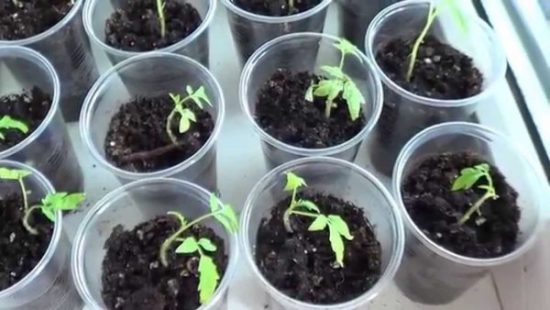
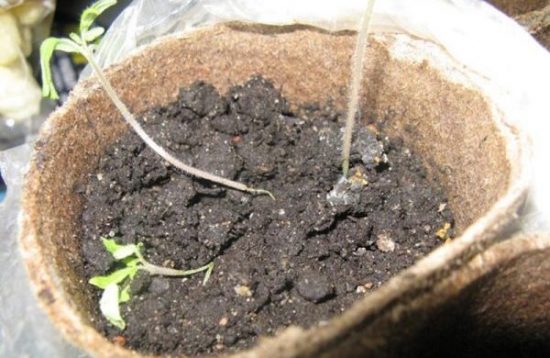
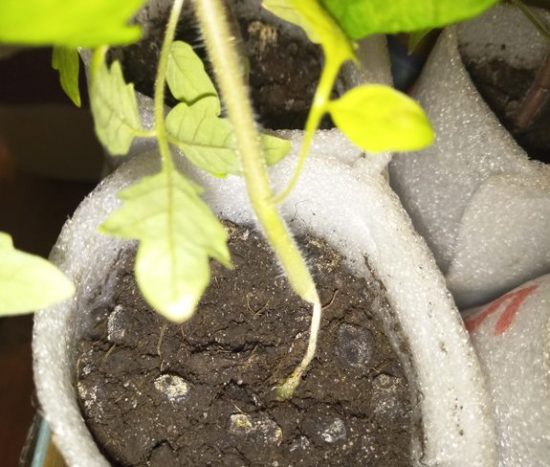
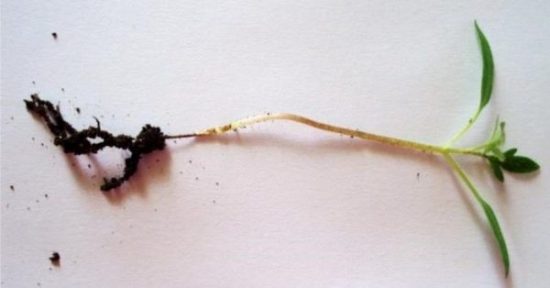
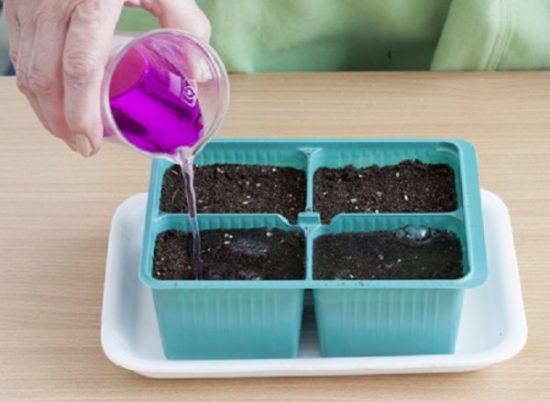
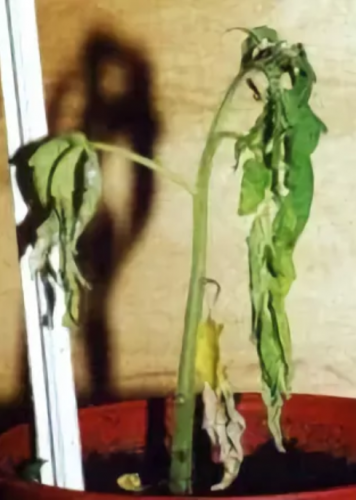
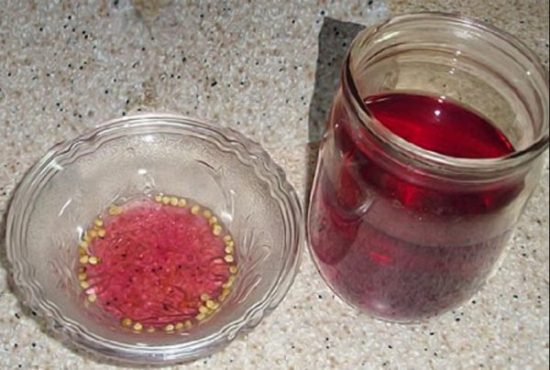
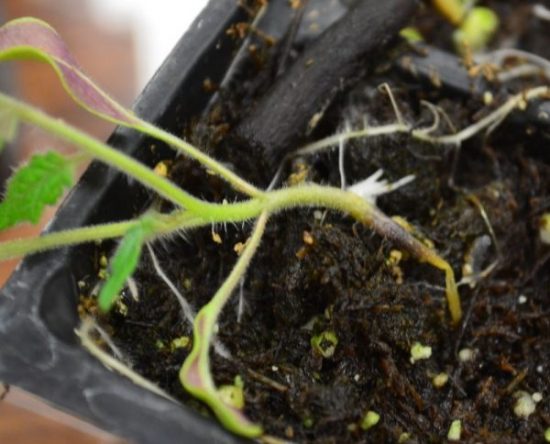
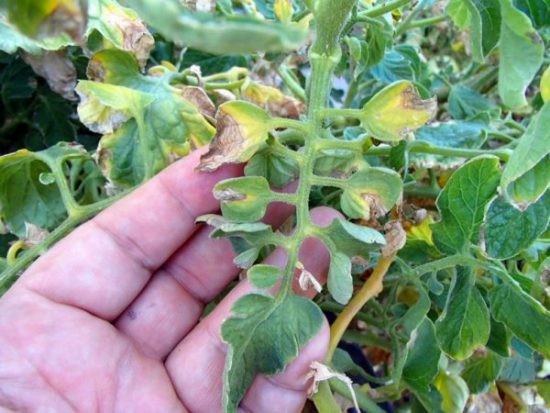
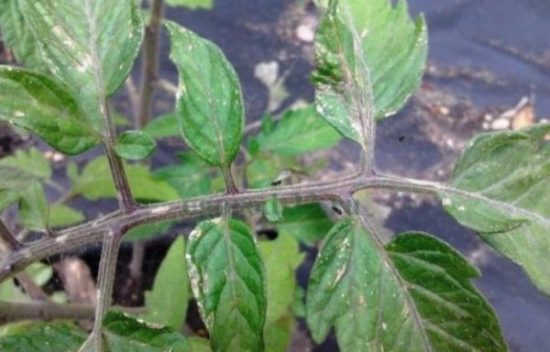
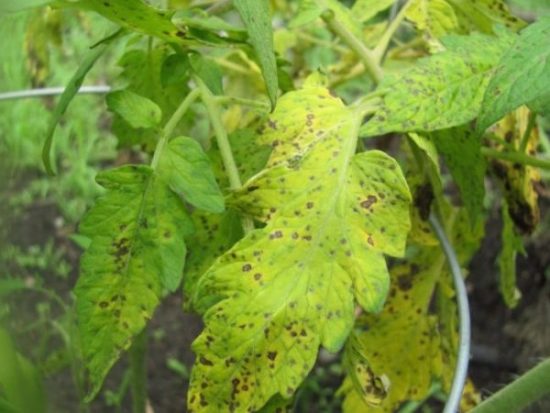
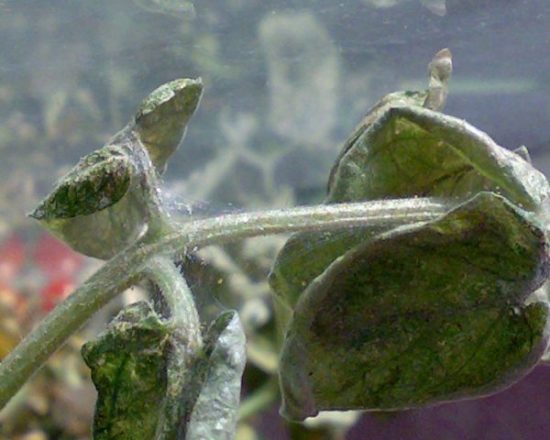
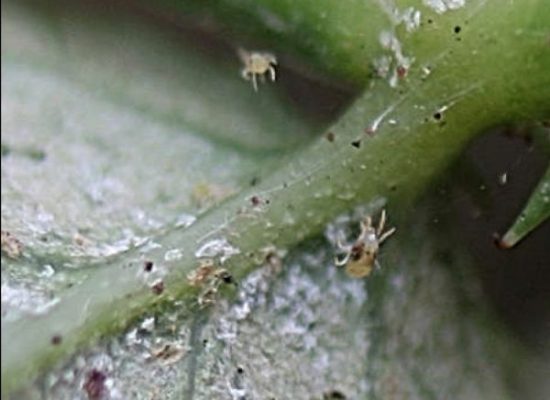
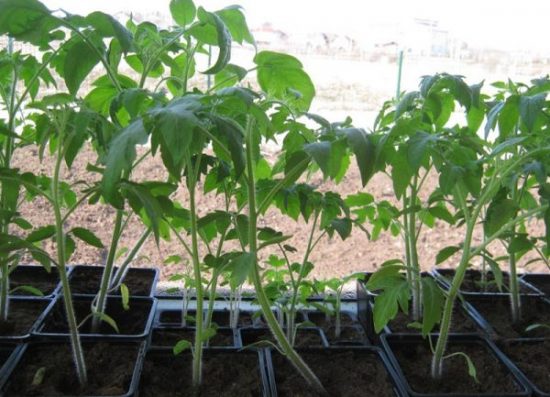
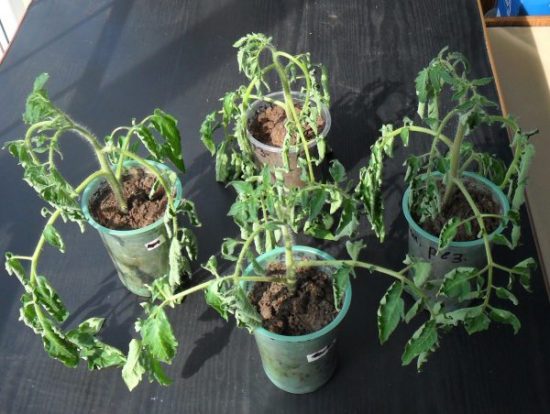
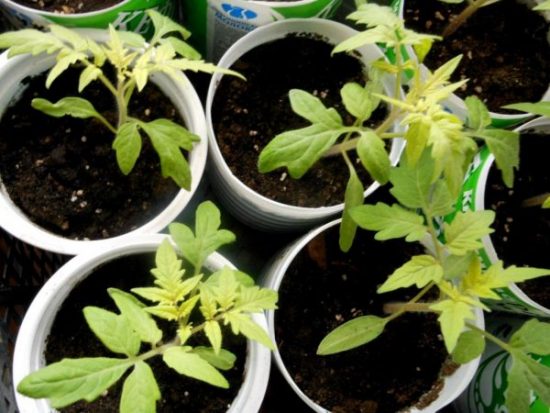
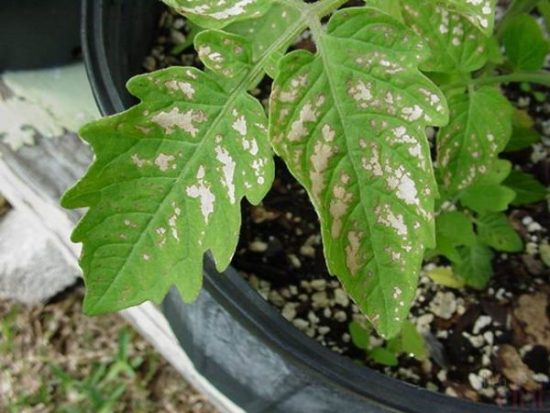


 (25 ratings, average: 3,76 out of 5)
(25 ratings, average: 3,76 out of 5) CUCUMBERS NEVER GET SICK, I'VE BEEN USING ONLY THIS FOR 40 YEARS! I SHARE A SECRET WITH YOU, CUCUMBERS ARE LIKE THE PICTURE!
CUCUMBERS NEVER GET SICK, I'VE BEEN USING ONLY THIS FOR 40 YEARS! I SHARE A SECRET WITH YOU, CUCUMBERS ARE LIKE THE PICTURE! You can dig a bucket of potatoes from each bush. Do you think these are fairy tales? Watch the video
You can dig a bucket of potatoes from each bush. Do you think these are fairy tales? Watch the video
 How our fellow gardeners work in Korea. There is a lot to learn and just fun to watch.
How our fellow gardeners work in Korea. There is a lot to learn and just fun to watch. Eye trainer. The author claims that with daily viewing, vision is restored. They don't charge money for views.
Eye trainer. The author claims that with daily viewing, vision is restored. They don't charge money for views. A 3-ingredient cake recipe in 30 minutes is better than Napoleon. Simple and very tasty.
A 3-ingredient cake recipe in 30 minutes is better than Napoleon. Simple and very tasty. Therapeutic exercises for cervical osteochondrosis. A complete set of exercises.
Therapeutic exercises for cervical osteochondrosis. A complete set of exercises. Which indoor plants match your zodiac sign?
Which indoor plants match your zodiac sign? What about them? Excursion to German dachas.
What about them? Excursion to German dachas.
There is a remedy against blackleg! I cured two adult pepper plants, already in bloom... Monarda is a remedy sold by the Faberlic company, and this year I also saved strawberries, 90% died from blackleg, I sprayed the remains with Monarda and they continue to grow unharmed... And the peppers last year , I sprayed the stems every day and at the site of the disease, half of the stems were eaten by the disease, everything was overgrown and they bore fruit, a little worse than everyone else, but also normal...
Irina, what kind of drug is Monarda? Is this a remedy for treating plant diseases? Can you buy it in Garden Garden stores?
Alexandra, “Monarda” is not sold in “Garden Garden” stores. This is a product for purifying air and surfaces from moldy fungi that cause headaches, allergies, fatigue, and depression.
Reduces the spread of viral diseases. This is the first time I've heard of it being used to treat plants.